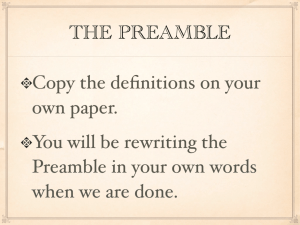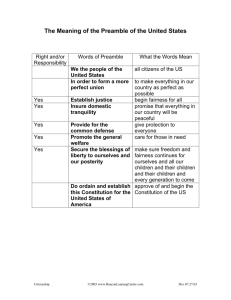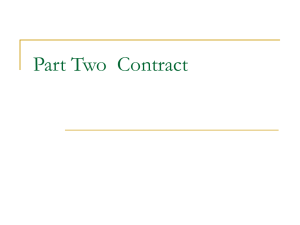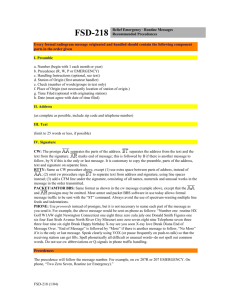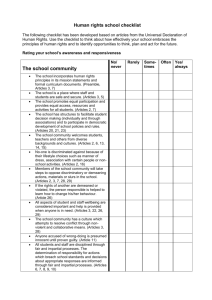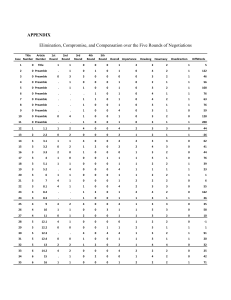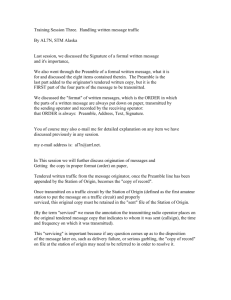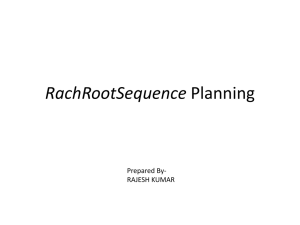NTS-session2
advertisement
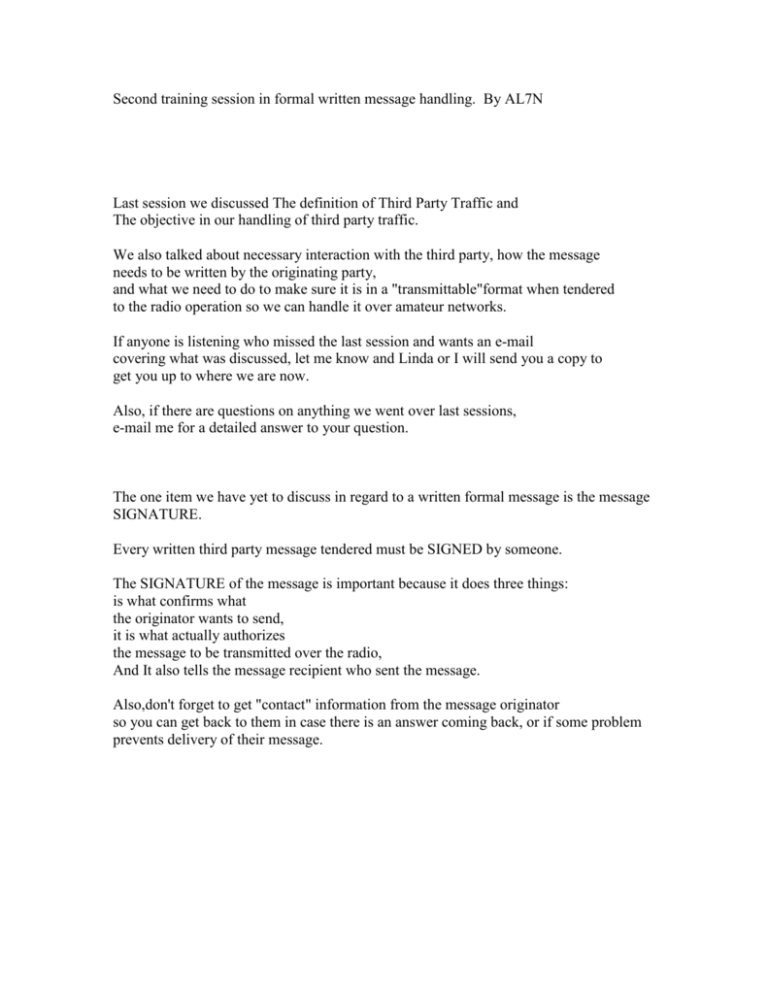
Second training session in formal written message handling. By AL7N Last session we discussed The definition of Third Party Traffic and The objective in our handling of third party traffic. We also talked about necessary interaction with the third party, how the message needs to be written by the originating party, and what we need to do to make sure it is in a "transmittable"format when tendered to the radio operation so we can handle it over amateur networks. If anyone is listening who missed the last session and wants an e-mail covering what was discussed, let me know and Linda or I will send you a copy to get you up to where we are now. Also, if there are questions on anything we went over last sessions, e-mail me for a detailed answer to your question. The one item we have yet to discuss in regard to a written formal message is the message SIGNATURE. Every written third party message tendered must be SIGNED by someone. The SIGNATURE of the message is important because it does three things: is what confirms what the originator wants to send, it is what actually authorizes the message to be transmitted over the radio, And It also tells the message recipient who sent the message. Also,don't forget to get "contact" information from the message originator so you can get back to them in case there is an answer coming back, or if some problem prevents delivery of their message. Now that we have the tendered message in writing in a suitable manner from the originating party, which contains the "name-to" and address, the text, and the originator's authorizing signature, We'll discuss the Message Preamble, which is the "first" of the four parts of a formal written message. Prior to transmitting a written third party message, we (that is, the operator of the Station of origin) must append a Single line of information at the top of the tendered originated message copy (this copy then becomes the copy of record). This single line of information is called the PREAMBLE (Note it is not a "header...a header is the overhead computer forwarding systems add to messages, and headers are NOT part of the message proper). The Preamble line becomes and is retained as a permanent part of the message "copy of record" and stays with the message through to delivery. The Preamble line contains certain items of information that help us route the message through to destination, and also allows tracing a message if that becomes necessary for any reason. There are eight items in the message preamble line, six are mandatory, and two are optional with the message originator. They are always transmitted in order from left to right, and will be expected to come that way by a receiving operator. (Refer to an ARRL printed radiogram blank, or a copy of ARRL Field Services Department Operating Aid 218 [FSD-218]) (If you do not already have a copy of FSD-218, I have a .pdf file I can send you via e-mail. Let me know.) It must be understood that the message originator is not the party responsible for appending the Preamble to a written message original copy...that responsibility lies with the originating amateur station after the signed message copy is tendered for transmission. The first mandatory item in the Preamble line is a MESSAGE NUMBER. This is an arbitrary but unique number that is assigned by the originating amateur station. Its purpose is to identify the message so it's route can be tracked through the chain of relay to delivery.. Normally it will be a sequential number which sequence starts at the first of a year or possibly the first of a month, depending on the originating station's numbering method. The second item in the Preamble is the mandatory message PRECEDENCE. The Precedence serves to allow the message to be prioritized according to urgency by the amateur stations originating, relaying,or delivering it. There are four levels of Precedence in amateur message work: Highest EMERGENCY This precedence is used only in life threatening situations, and is very rare. Any message carrying EMERGENCY precedence is always moved before ANY other traffic.( the word EMERGENCY is always spelled out in full in the preamble) Next highest Priority (abbreviated with the single letter "P" (as in PAPA) in CW and digital modes) Time-sensitive. Important, but not an emergency. Always moved before any lower precedence traffic. Third highest Welfare (abbreviated by the single letter "W" (as in WHISKY) in CW and digital modes) Has to do with the well-being of person or persons. May be originated at a shelter operation, etc. Always moved before routine precedence traffic. Lowest Routine (abbreviated by the single letter "R"(as in ROMEO) in CW and digital modes). This is any other traffic which is moved only after all higher precedence traffic has been cleared. The third item in the Preamble is an optional ARRL "Handling Extra" code. (See Operating Aid FSD-218 for a description of these codes) Since the HX code is optional, We won't discuss them further at this time. The fourth mandatory item in the Preamble is the callsign of the "Station of Origin". The Station of Origin is by definition the FIRST station to put the message on a traffic circuit. The fifth mandatory item in the Preamble is the "Check" number, which is the count of the words and/or groups in the message TEXT only. We will discuss the "check" and how to count it in more detail later in this course. The sixth mandatory item in the message Preamble is the "Place of Origin". This is the location where the message actually originates from, and may or may not be the same as where the "Station of Origin" is located. Sometimes messages might originate at one place and then be hand-carried to the place where the working radio is. Example: A message originating from the FNSB EOC, or perhaps a shelter location, then taken to an amateur station elsewhere in the local area for transmission. The seventh item in the Preamble is optional with the originator, and is the "Filing Time". What the Filing Time actually is seems to be often misunderstood. The filing time in the Preamble is the time the radio message is written out by the originator and tendered to the radio operation for transmission. In other words, it is the time the message is filed into the "to be sent" file of the amateur Station of Origin. It is necessarily an earlier time than the time when the message is actually transmitted on a circuit. Not all messages will have a filing time. Routine messages often do not. However A filing time should always be included in the Preamble of any message of a "time sensitive" nature, such as Priority, Welfare or Emergency messages. The filing time, if included, should generally be in UTC (Zulu) time, and always in "24 hour" format, particularly if the message will cross a timezone boundary enroute to it's destination. It is permissible to use "local" time for messages that will not cross a timezone boundary, but if "local" time is used, be sure to indicate that it is. Example" A four digit time (24 hour format) with the suffix "L" (as in LIMA). The eighth and last mandatory item in the message Preamble is the Date. The date is properly expressed by the three-alpha character standard abbreviation of the Month, followed by a one or two digit day of the month. "MMM DD" Example: A message filed this evening would carry "JUN 1" as the date. Current year is always assumed. Note that If UTC (Zulu) time is used for the filing time, the date on any such message should also match the time in UTC. Example: a message originated at 8:00 PM Alaska Local Daylight Time on June 8, would carry the origination time of 0400Z June 9, using ZULU time. We need to talk a little about the message "FORMAT"... By message FORMAT, we mean the ORDER in which the four parts of the message are put down on paper in the original tendered copy or "Copy of record", the order they are transmitted over the air by the sending operator, and the order they are copied down on paper by the receiving operator. This "order" of message parts is always the same, and is the order of the parts of the message that any trained radio operator will expect to come over the air. Remember...Always: Preamble Address Text Signature... In that order. This concludes our second training session...For homework, Go to the ARRL WEB site URL: arrl.org Download and Study the ARRL FSD-218 Operating Aid document closely and become familiar with the message written format in general, and the eight message Preamble items in particular. Practice writing written radiogram messages using what we have learned so far. End of training session 2 AL7N
